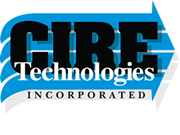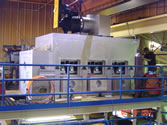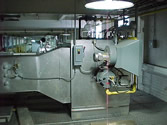Log in
Cire Technologies Blog
Principles of Direct Impingement Dryer Design Series - Paper No. 6 of 8
The Primary Components of an Impingement Dryer – Part 1
Dryer Housing
The dryer housing should be constructed with insulated wall panels designed to account for the thermal expansion caused by the dryer interior temperature. Depending on the operating temperature of the dryer the thickness of the insulation and thus the housing wall thickness will vary. Though each project requires its own wall/insulation thickness analysis a fair rule of thumb is that the wall/insulation thickness should be at least as thick as the maximum operating temperature in °F divided by a hundred. Regardless the wall should be designed to keep exterior skin temperatures below code guidelines for operator safety. Besides, radiant heat loss can produce uncomfortable working conditions and wasted energy costs, and insulation is a relatively minor cost of a dryer fabrication.
The dryer wall construction we recommend consists of the insulation, rated above the dryer operating temperature, sandwiched between two metal skins. Depending on the application the interior skin will usually be either aluminized steel or stainless steel and the exterior skin is usually aluminized steel or mild steel, painted. Wall panels should be tongue and groove construction, allowing for thermal growth without distorting the interior skin. The dryer walls can be either supported by an interior or exterior structural frame, we prefer an exterior frame because it protects the wall panels and allows for easier installation.
Heat Source
The heat source for the dryer will vary depending on the availability of energy at the process facility and the process itself. Typical sources are listed below.
- Burner Systems: A natural gas, propane or more rarely an oil fired burner is a common source of heat. These are cost effective forms of heating and provide a wide range of operating temperatures and good temperature uniformity when properly designed. We will discuss burner types in more detail in future blog entries.
- Electric Heat: Where heat loads are small, fuel sources are unavailable or process considerations preclude burner provided heat, electric heaters can be used. Though there are a number of electric resistive type heaters, to supply the heat density and temperature typically used in dryers and ovens we recommend tubular heaters which used sheathed heating coils mounted in the dryer or oven supply air system. Very good temperature control is achievable with SCRs combined with PID temperature controllers.
- Steam or Hot Oil Systems: These systems of supplying heat to dryers are usually only considered when a plant wide steam or hot oil system is available due to the high initial cost of boiler and hot oil heater installations. These systems use steam or hot oil run through coils mounted in the supply air ductwork to the dryer and controls the supply temperature with modulating control valves in the supply steam or hot oil piping. Good temperature control is achievable with these systems though response time can be slower to process upsets than with burner and electric heat systems.
- Indirect Heat or Feedback Systems: Detailed descriptions of these systems are beyond the scope of this blog entry. Basically, indirect heat is used in dryers where burners are used but for process reasons there is a desire to keep the products of combustion or the burner flame out of the supply and recirculating air heating systems. This is often a clean room concern or processing silicones, where contact with the flame creates silica dioxide dust, a contaminant. Feedback systems utilize waste heat from the dryer and or an oxidizer connected to the process line to supplement the heating, or where possible, supply all of the heat necessary for the process. Feedback systems can be direct, where the waste heat air is used directly back in the oven or dryer, or indirect, where the waste heat is fed back to the process after passing through a heat exchanger, often air-to-air but at times through steam or hot oil systems.
Supply Air Fan (Recirculation Fan)
To supply the means to blow the impingement air onto the product a supply air fan is needed. This fan is often called a recirculation air fan. Because once through air systems require a great amount of energy to heat the supply air which would be fully exhausted after being impinged onto the product, recirculating air systems are almost always used. Though some of the air from the dryer after it is impinged on the product is exhausted, most of the air, which still is at an elevated temperature, is recirculated back to the dryer supply fan. This significantly reduces the energy needed in the dryer. Characteristics of the supply fan should include the following:
- The fan should be a centrifugal fan with an airfoil wheel, the most efficient, or a backward inclined wheel, almost as efficient as the air foil wheel.
- The fan should be insulated where dryer temperatures are high to protect personnel and minimize radiant heat losses from the process. Plug type fans are often built into the insulated dryer housing or auxiliary equipment in these applications.
- The fan motor should be rated for use with variable frequency (speed) drives. We recommend all fans utilize VFDs to provide flexibility to the process, the most efficient control of air flow and reduce wear and tear on the fan components through the use of ramped instead of full speed starts.
- The fan can be belt or direct driven. Belt drives provide some additional flexibility in matching air flow characteristics to the process, however with the use of VFDs direct drive systems can often match the process requirements and are usually cheaper.
When you subscribe to the blog, we will send you an e-mail when there are new updates on the site so you wouldn't miss them.





Comments